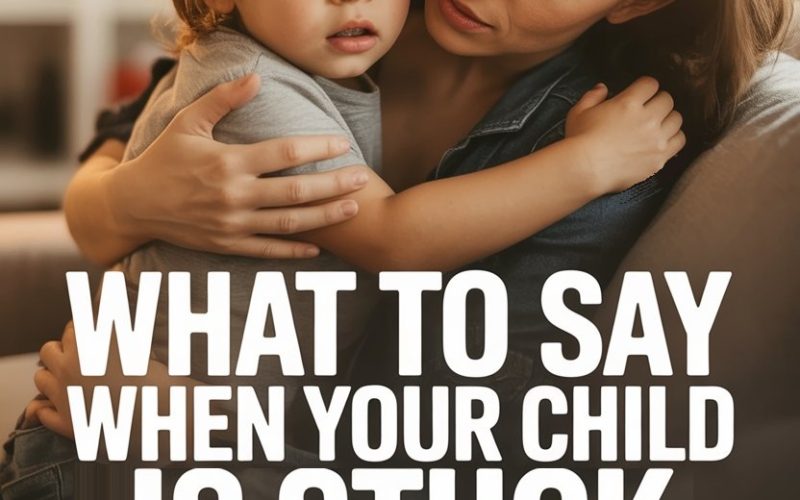Ever tried reasoning with a petrified six-year-old convinced there’s a werewolf in the wardrobe? Fun times.
For parents, fear is a frequent dinner guest—whether it’s monsters, thunderstorms, or the possibility of broccoli for tea. Sometimes, you’re dealing with a child who’s frozen in place, unable to budge past a particular worry.
And if you’re reading this while hiding in the loo for a moment of peace, you’re not alone.
Let’s get real about what actually helps—what you can say and do when your child’s fears have them well and truly stuck.
Why Fear Sometimes Sets Like Concrete
Every child gets scared sometimes. For some, it’s the dark; for others, it’s that strange guy dressed as a dog at the shopping centre (and honestly, who can blame them?).
Fear has a job: to protect us from possible danger. But young brains are still learning to tell the difference between “genuine threat” and “mum just sneezed.”
Occasional worry is part of growing up. But when fear has your child stuck—refusing to enter a room, try a new activity, or even leave your side for the loo—words really matter.
Before You Start Talking
Panic loves company. If you respond to your child’s fear with frantic reassurance or eye-rolling exasperation, you’re handing fear a megaphone.
Take a breath. Find your inner Mary Poppins (or at least your outer Mrs. Doubtfire).
Keep your voice calm and even, even if inside you’re thinking, “Oh dear Lord, not this again.”
Validate Their Feelings Without Fanning the Flames
It’s tempting to go full detective or motivational speaker: “There’s nothing to be scared of!” or “You’re so brave!” But dismissing or overhyping doesn’t help a child who’s locked in terror.
Try: “I can see you’re feeling really scared right now. That must be tough.”
This signals you’re on their team. Research on emotion coaching by psychologist John Gottman shows that children who feel understood by their parents are better able to manage big, scary feelings.
(Don’t worry, you don’t have to be a therapist. ‘Wow, you’re really worried!’ is a solid start.)
Name the Fear Together
There’s power in putting words to what’s going on. Ask gently, “Can you tell me what’s making you afraid?”
Even if it sounds a bit bonkers to your adult brain—killer bees in the toilet bowl, anyone?—naming the fear helps drag it into daylight.
If your child can’t name it, try offering options: “Is it that it’s dark in there? Or something else?” Sometimes kids “borrow” words from you, so keep your language neutral.
The trick is to describe, not diagnose. “You’re scared the thunder is too loud,” not “You’re always so anxious about storms.”
Avoid the Temptation to Over-Reassure
Reassurance is like chocolate—great in moderation, but overdoing it only encourages the craving.
Constantly telling your child, “It’s fine, nothing bad will happen!” may actually convince them that there is something to worry about.
Instead, focus on being present. A simple: “I’m here with you. We’ll figure this out together,” works wonders.
Breathe, and Invite Them to Join
When your child is trapped in panic, their brain is in full fight-or-flight mode. Logical pep talks bounce right off. What often helps is going back to basics: breathing.
Try: “Let’s take a soft slow breath together. Want to try blowing out like we’re cooling a cup of tea?”
Don’t force it, but model it. Watching you breathe and relax is often more calming than anything you say.
Share a Time You Felt Scared
Our kids see us as omnipotent snack providers, but they don’t always realise grown-ups get scared too. Briefly sharing a time you felt afraid—and how you handled it—can normalise their experience.
“I remember feeling butterflies before my first big meeting at work. My heart raced just like yours does sometimes!”
Just don’t make it about you for too long. This isn’t an audition for your own Netflix special.
Encourage Tiny Steps, Not Giant Leaps
Telling a fearful child to “just do it” is like handing someone a parachute and shoving them out the plane. Instead, break the feared situation into manageable bites.
If the dark hallway is the villain, suggest: “Let’s stand together just at the edge. How does that feel? When you’re ready, we’ll go a bit further.”
Celebrate each victory, no matter how small. (No one else may care about the Great Spider Cupboard Triumph, but you know it’s a big deal.)
Let Your Child Lead the Pace
Nothing dials up panic faster than a parent on a mission. Gently ask: “Do you want to try now, or would you rather watch me?”
When your child feels some control, fear shrinks down to size. This doesn’t mean avoiding the scary thing forever, just allowing them to set the tempo.
Use Play and Imagination
Play is a child’s natural language. If fear is getting the upper hand, get silly. Give the fear a ridiculous name (Sir Snarl-a-lot, Queen Screechy) and draw it together.
Role-play can help too: “Let’s pretend I’m the monster under the bed and you’re the brave knight!”
Sometimes, a magic torch or an invisible shield (aka a sock) is all it takes to make things less terrifying.
Invite Problem-Solving, Not Perfection
You don’t need all the answers, promise. Try, “What do you think might help you feel braver next time?”
Even young children often surprise you with creative ideas—one six-year-old I know insisted on wearing her bicycle helmet during thunderstorms.
If your child is fresh out of ideas, offer a couple: “Would you like me to hold your hand, or shall we sing your favourite song together?”
Avoid Bribes and Threats
It’s tempting to promise treats or threaten consequences (“If you don’t go to sleep, no telly tomorrow!”), but this teaches kids that fear is either something to be squashed with chocolate or ignored until you lose it.
Neither helps your child learn that fear can be managed, not just avoided or bribed into submission.
Teach Simple Coping Skills
While you’re not expected to run a mindfulness retreat in your lounge room, a few simple tricks can help. Try grounding exercises: “Tell me two things you can see, two things you can hear, and two things you can touch right now.”
You’ll find lots of ideas in this University of Rochester Medical Center guide, but the best coping tools are the ones your child actually likes and uses—be it singing, drawing, or squeezing a stress ball shaped like a potato.
Don’t Rush to Rescue Every Time
It’s hard to watch your child struggle. You’d scale a mountain in your pyjamas if it meant easing their fear. But always swooping in to fix things tells your child they can’t handle fear without you.
Instead, give just enough support for them to stretch—then cheer them on as they figure out their own way forward. (Think of yourself as the world’s most enthusiastic spotter on the toddler balance beam.)
When Fear Sticks Around
Sometimes, no matter what you say or do, your child’s fear is stubborn as a mule. If fear starts interfering with everyday life—school, friends, sleep—it may be time to chat with a mental health professional who works with kids.
You’re not failing. You’re being a top-notch parent by reaching out for the right help.
What to Say Tonight (Without Needing a PhD)
The next time your child’s locked in fear, you’ve got options that actually help. You can acknowledge their feelings, help them name what’s scary, and encourage tiny steps forward.
You might even find yourself wearing a colander on your head to show that “monster-proof helmets” are a thing.
Parenting doesn’t come with a manual, but a bit of empathy (and maybe a torch under the pillow) goes a long way.
Your child’s fear won’t last forever. But your support—and your sense of humour—makes all the difference.





